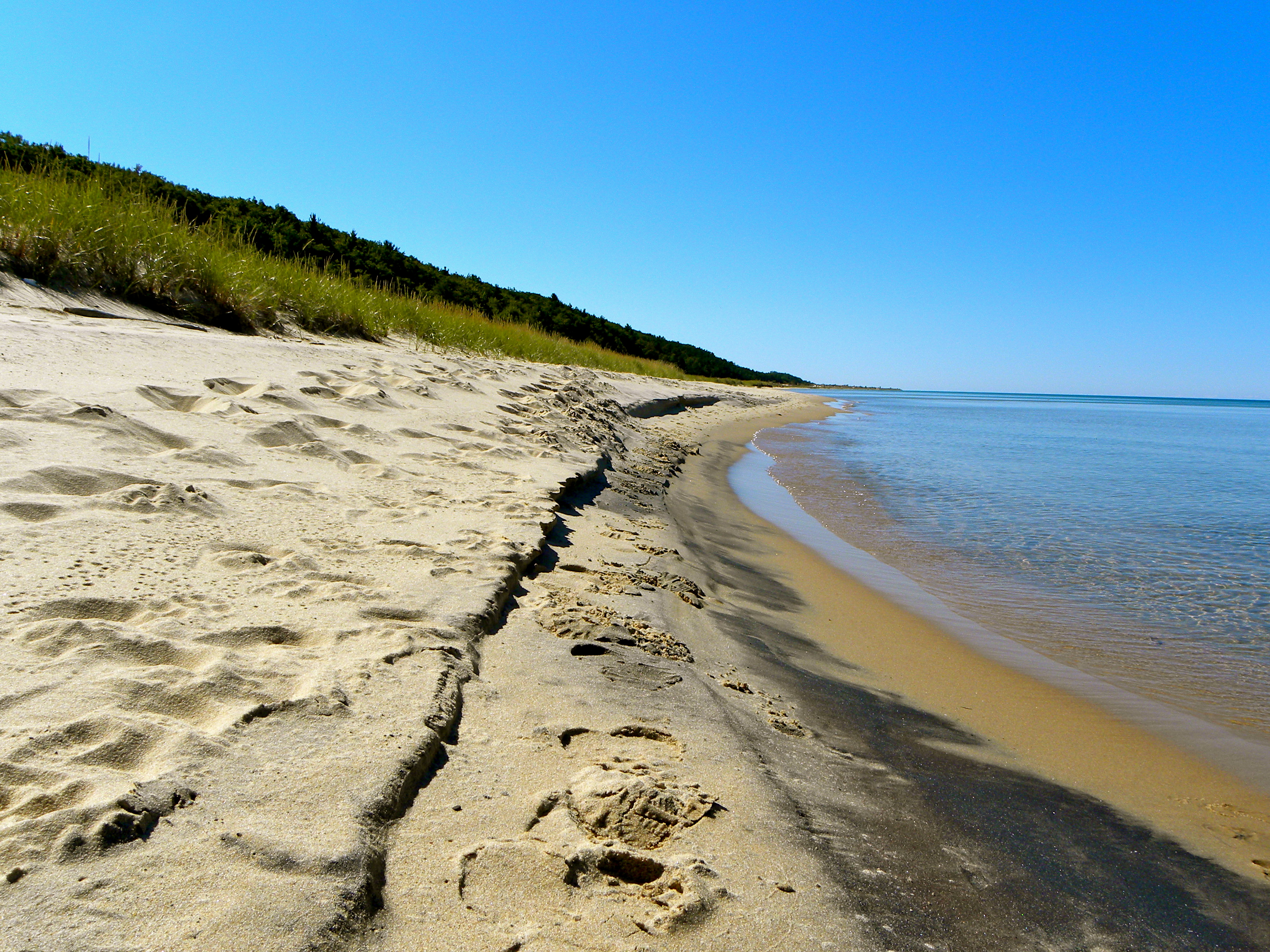
Lake Michigan beach. Image: Jennifer Kalish
By Carl Stoddard
Capital News Service
A popular program that helps Michigan beachfront communities improve their shorelines is jeopardized by proposed federal budget cuts.
The Trump administration recently recommended a 17 percent cut in funding to the National Oceanic and Atmospheric Administration (NOAA) which supports the Coastal Zone Management Program.
The program awards about a dozen Michigan grants a year, and such a cut could limit the number and amount of the coastal grants, said Rachel Coale, outreach coordinator for the Michigan Office of the Great Lakes.
The administration’s proposed cuts could be a loss for Michigan and the country, said Brad Garmon, director of conservation at the Michigan Environmental Council.
NOAA’s coast grants are “a vital investment, especially to a state like Michigan that’s defined by water,” Garmon said. “What would Michigan be without our Great Lakes coastlines?”
The coastal grant program, which has awarded two grants to the Lansing-based council, “works well because it allows states the flexibility to decide which coastal issues and projects are most important,” he said.
In Oscoda Township, $200,000 from the program helped build a $1-million pier in 2012 that juts 300 feet out into Lake Huron. In South Haven, a $65,000 grant is helping restore an historic, 50-foot wooden fishing boat. And on Beaver Island, $21,000 was awarded to develop a water trail system around the Lake Michigan island.
Created in 1978, the program is a joint effort of the state and NOAA.
Most grants require a match from the local community, usually 50-50, Coale said. On average, grants in Michigan range from $15,000 to $125,000.
“Our mission is to protect, preserve, enhance and restore Michigan’s coastal region,” she said. “We have more than 3,000 miles of coast, so that’s significant.”
The program targets projects that “improve water quality, protect healthy coastal ecosystems, preserve historic maritime structures and enhance public access to Great Lakes coastal resources,” she said.
The grants have had a big impact on coastal communities around the state.
“The fishing pier in Oscoda Township is one such project,” Coale said.
The pier, built on the northern end of the Oscoda Township Beach Park, opened to the public in the fall of 2012, said Ann Richards, director of the township’s Downtown Development Authority. In addition to the coastal program, the project received support from state and township funds.
It’s popular with local residents and visitors, she said. “It’s basically woven into the fabric of our community. It’s a beautiful place.”
The community’s Fourth of July fireworks are now launched from it and the pier is a favorite spot for wedding and prom photos.
Several other public access projects around the state also have been funded, at least in part, by the coastal grants, Coale said.
They include the beach stairway in Allegan County’s Casco Township, the water trails development around Wayne County’s Belle Isle State Park, the Fort Gratiot Lighthouse project in St. Clair County, restoration of the 1939 Evelyn S. commercial fishing tug in South Haven and the kayak launch on the Black River in St. Clair County.
The program recently announced nearly $1 million in grants for 11 “creative coastal projects.” All projects also will be funded by matching local grants. They include:
- A $15,000 grant is earmarked for development of the Lake St. Clair waterfront in Macomb County’s Harrison Township.
- A $100,000 grant was awarded to the non-profit Michigan Environmental Council to study and map Michigan’s sand dunes.
- Van Buren County is getting $50,000 to restore and stabilize 20 acres of sand dunes along Lake Michigan.
- The city of St. Joseph in Berrien County was awarded $20,000 to conduct a five-year review and update of its 2012 coastal study.
- A $90,000 grant is going to the 600-acre Headlands Park & Boardwalk along Lake Michigan in Emmet County. The park was designated an International Dark Sky Park in 2011, “which has brought waves of visitors from across the nation,” according to the Coastal Zone Management program. The money will be used to build a pathway and boardwalk from the park’s two parking lots to the shoreline.
- Another $21,000 will go to Beaver Island, which is about 30 miles offshore from Charlevoix in Lake Michigan, to develop a master plan for a water trail system. It is intended for use by kayaks, canoes and paddle boards, according to a proposal by St. James Township on the island. The proposed route will circumnavigate 50 miles of the Beaver Island shoreline and include campsites and points of interest, the township says.
- Clair County is getting $50,000 in matching grant funds to enhance public access to its River Walk with construction of a 160-foot wood boardwalk, a wetland overlook and a concrete plaza.
- A $30,000 grant is going to the Coastal Beach Initiative “to run the statewide Adopt-A-Beach Program to clean up and monitor” about 140 coastal beaches in Michigan, the state says.
The remaining grants will go to study coastal land uses, support the state’s Clean Marina Program and to protect Michigan’s underwater shipwrecks.
In previous years, the program has awarded grants to a variety of communities and programs, including: East Bay Township in Grand Traverse County, $45,000; Casco Township, $24,500; Ottawa County Parks & Recreation, $45,000; Northeast Michigan Council of Governments, $37,265; Central Michigan University, $100,000; Heart of the Lakes, $51,710; Department of Natural Resources’ Parks & Recreation Division, $40,000; Eastern Upper Peninsula Regional Planning & Development, $18,500; Northwest Michigan Council of Governments, $98,838; Sault Ste. Marie, $30,000; and Spring Lake Township, $11,000.
